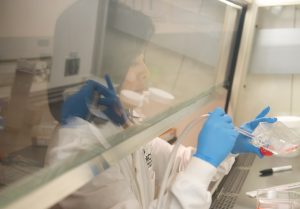Health Canada has approved a clinical trial for new technology developed by Toronto-based researchers that offers new, less-invasive ways to manage cancer.
Nanoparticles are very useful vehicles for delivering drugs and imaging agents to tumours, and a type of lipid nanoparticle developed by Dr. Gang Zheng and his team, called porphysomes, takes this versatility to the next level.
Porphysomes are unique in their ability to absorb high amounts of light. They can be used in imaging tumours and guiding surgery as well as ‘photo-dynamic’ therapies that use light to destroy cancerous cells. They also offer another advantage in that they accumulate in cancerous cells but not healthy ones, thereby improving accuracy and minimizing damage to surrounding tissue. After spending many years of testing and improving this technology, Zheng is about to see it graduate from the lab to the clinic through a clinical trial that was recently approved by Health Canada.
“We are thrilled to be taking this big step into the clinic and are very excited about the potential of porphysomes to make a meaningful difference for people with cancer,” says Zheng, who is a Senior Scientist at the University Health Network’s Princess Margaret Cancer Centre (PM). “The intrinsic multifunctionality of this technology and its selective infiltration of tumours make it a promising platform for imaging and treatment across many types of cancer.”
Phase 1A of the clinical trial is expected to begin in June 2025 and will be overseen by Dr. Stéphanie Lheureux, a clinician-scientist at PM. It will evaluate the safety of porphysomes in patients with metastatic ovarian cancer and will allow researchers to see where the nanoparticles accumulate and how they interact with the body.
To do so, they will be ‘radiolabeled’ with Cu-64, a radioactive form of copper. This work will be done at the University of Toronto’s Centre for Pharmaceutical Oncology GMP facility run by Dr. Raymond Reilly. Zheng is grateful for that collaboration and the OICR support that helped make it happen.
“OICR’s support was of paramount importance to the production of porphysome-Cu-64 from initial development to the eventual first in-person dose,” says Zheng. “By enabling our partnership with Dr. Reilly, we were able to develop a radiolabeling protocol that met Health Canada’s very strict requirements. Without this the trial would not have been able to move forward.”
If the results of this first stage are positive, the research team will move to begin Phase 1B of the trial which will also examine safety, but across several different cancer types. Zheng and his team are happy to see porphysome-Cu-64 reach this critical stage, which has provided further inspiration for what could be next.
“The versatility of porphysomes means that there are almost an endless number of possibilities when it comes to their use in cancer. We can load them with various drugs and radioisotopes, and we have even seen an immune response to porphysomes and photodynamic therapy in some preclinical research,” explains Zheng. “Launching this clinical trial is momentous in part because it is key to unlocking these possibilities and unleashing the full potential of this technology.”
Dr. Gang Zheng’s research is supported in part by an OICR Clinical Acceleration Team Award (co-PIs Dr. Amit Oza, Dr. Jonathan Irish and Dr. Marcus Bernardini). His work is also supported by the Terry Fox Research Institute and the Princess Margaret Cancer Foundation.



